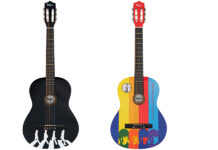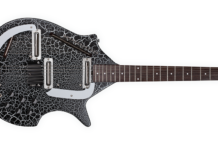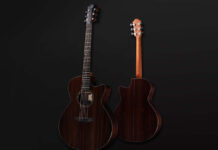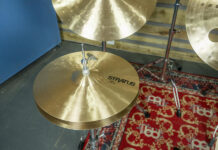
Allan Holdsworth's Four-Note-Per-String Scales
I often get asked about two topics: How to play in a modern style and how to break out of box patterns.
Though these are two separate ideas, I often start by giving one answer: Check out four-note-per-string scales.
Used by modern players such as Allan Holdsworth (1946-2017), whose playing inspired me to check out these fingerings, four-note-per-string scales can help bring a more modern flavor to your lines, expand your knowledge of the neck and allow you to cover a large amount of fretboard real estate with just one scale shape, all of which are beneficial to players looking to explore non-traditional scale fingerings in their playing.
In this lesson, we’ll be looking at how to play and practice four-note-per-string scales, as well as how to add slurs into the mix in order to get a bit of that “slippery” Holdsworth legato sound into your lines.
Four-Note-Per-String Scales
These scales are built exactly as their name suggests, by playing four notes on each string as you climb up the neck, then simply reversing this approach on the way down. While these scales lie nicely under the fingers once you get them down, there are two roadblocks many players face when exploring these scales for the first time, finding the notes and finding a fingering that works for you.
When first digging into a new four-note-per-string scale, such as the F major scale below, you will need to figure out the notes on the scale and build your fingering up from there. Here is the process I used to work out the notes in the example below.
• Pick a scale, in this case F major
• Write out the notes of that scale, F G A Bb C D E
• Start on the tonic, F, and play the first four notes of the scale on the 6th string, F G A Bb
• Then, move to the next note in the scale, C, on the 5th string and play the next four notes, C D E F
• Repeat this process up all 6 strings So the process for learning the fingering for this scale is different from a typical box pattern or in-position two-octave scale, which can make it a bit tricky at first.
But it does have the added side effect of shoring up your knowledge of the notes on the neck at the same time that you learn the scale, so it’s a worthwhile exercise for both of these reasons. As far as the fingering is concerned, it will depend on your hand and finger size and dexterity. I play these scales with one finger per note, 1-2-3-4 across each string, but not everyone will feel comfortable with this fingering.
If you find that the 1-2-3-4 fingering on each string is uncomfortable, you also can try 1-1-2-4, 1-2-4-4 or other combinations of these fingers that sit well with your hands on the guitar. Check out this scale below, and then take it to as many keys as you can across the neck before moving on to the slur exercises that follow.
Depending on how many frets you have, you may be able to get it up to the key of C, if you have 24 or Bb if you have 22.
Adding One Slur to 4NPS Scales
Now that you’ve checked out a four-note-per-string fingering on the guitar, we’ll begin to add in slurs, hammers and pull-offs in order to give these scales that “slippery” sound you hear when they’re used by players such as Holdsworth. All of the exercises below are also great for building fretting-hand technique, but they can also be very tiring on the fingers and fretting hand.
So go slow with these exercises, and if your hand begins to feel sore or overtired, just take a break, go have a cup of coffee or take the dog for a walk, then come back to this exercise when your hands are fresh. We’ll being the slur exercises with three different ways to add one hammer on the way up the scale and one pull-off on the way down. In the first example you will see a slur added between the first and second notes on each string. When you are coming down the scale, keep that same approach, putting a slur between the first and second notes on each string, but just use a pull-off when descending the scale fingering.

The next variation will feature a slur between the second and third notes on each string. Again, use a hammer going up the scale and a pull-off on the way back down. To get the most out of these exercises, make sure to use a metronome, starting at a slow tempo and slowly increasing the speed as you work these scale and slur variations in different keys across the neck.

The last one-slur example we’ll check out features a slur between the third and fourth notes. Once you have any/all of these slurs under your fingers, put on a backing track, maybe a static Fmaj7 chord or a ii-V-I progression in the key of F major, then improvise using this scale fingering and slur variations. The best way to see if you have really learned a new concept is to take it out and make some music with it. So, don’t feel like you have to get all of these ideas down before you begin to solo with them, just learn one slur option then go blow with it for a bit over a backing track. Then when that’s comfortable move on to the next slur and repeat the technique-improv loop.

Adding Two Slurs to 4NPS Scales
Since there are four notes on every string when using these fingerings, you can also practice adding two slurs in a row on each string of the scale. The concept is the same as when you added one slur, use hammers on the way up and pull-offs on the way down to complete the exercise. In the first example you will be adding a slur between the first, second and third notes on each string. If you are using the 1-1-2-4 fingering instead of 1-2-3-4, you can use a slide between the first two notes so that the slur becomes a slide plus a hammer on the way up and a slide plus a pull-off on the way down. This will allow you to work these slurs into the scale if you use an alternate fingering.

You also can add two slurs to the back end of each string but placing a slur between the second, third and fourth notes on each string in the scale. Again, if you are using the 1-2-4-4 fingering for each string, then you could do a hammer plus a slide going up and a pull-off plus a slide going down to achieve the same effect.

Adding Three Slurs to 4NPS Scales
Lastly, you can use slurs on all of the notes on each string, so only picking the first note and then slurring for the rest of the notes on each string in the scale. This type of legato approach is indicative of the Holdsworth style, so if you are going for that sound, this is a variation that you will want to check out and get under your fingers. Since there are more slides than picks, many players tend to lose focus on the time and rhythm with this exercise. A good way to avoid this is to set the metronome to 8th notes and then play one note per click to make sure each note is accurately placed within the bar.

Though not as common as in-position, the CAGED system or three-note-per-string scales, using four notes on each string can help you learn the notes of the neck, add more legato to your lines and break you out of box patterns at the same time. Do you use four-note-per-string scales in your playing or have a favorite way to practice them in the woodshed? Please share your thoughts in the comment section below.
Matt Warnock is the owner of mattwarnockguitar.com, a free website that provides hundreds of lessons and resources designed to help guitarists of all experience levels meet their practice and performance goals. Matt lives in the UK, where he is a senior lecturer at the Leeds College of Music and an examiner for the London College of Music (Registry of Guitar Tutors).
Source: www.guitarworld.com








